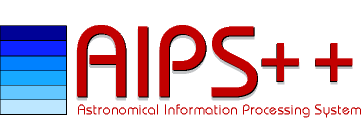
 News
News
| Getting Started | Documentation | Glish | Learn More | Programming | Contact Us |

| Version 1.9 Build 000 |
 News
News
|
WAIS
widget
WIMP
window
window system
wizard
world co-ordinate system
World-Wide-Web
WSRT
Wide Area Information Servers: a distributed information retrieval system. Clients are able to retrieve documents using keywords. The search returns a list of documents, ranked according to the frequency of occurrence of the keyword(s) used in the search. The client can retrieve text or multimedia documents stored on the server. WAIS offers natural language input, indexed searching for fast retrieval, and a "relevance feedback" mechanism which lets the results of initial searches influence future searches.
An element of a window-based user interface, or WIMP, such as a button, scrollbar, text editing area, etc. Programmatically, widgets are often expressed as data structures.
Windows, Icons, Menus and Pointers (or maybe Windows, Icons, Mouse, Pull-down menus): The style of user interface invented at Xerox PARC, popularized by the Apple Macintosh, and now available in other graphical user interfaces, such as the X Window System, Motif, MicroSoft Windows, etc. Also used as a derogatory term for those users who prefer such interfaces by those who do not.
1. In astronomy, a term used to describe a spectral range within which the Earth's atmosphere is relatively transparent to radiation, as in radio window, optical window.
2. In computing, a rectangular area of a computer screen that may be selected, moved and resized by a pointing device (or by other user inputs) while its contents (which may be text or graphics) are retained in the computer's memory.
Software which allows a computer's video screen be divided into windows which act like a separate input/output devices under the control of different application programs. The user may see the output of several processes at once and choose which one will receive input by selecting its window with a mouse or other pointing device.
A window manager is the part of a window system which arranges windows on a screen. It is responsible for moving and resizing windows, and other such functions common to many application programs.
A wizard is a graphical tool for taking a user through a simple set of steps towards some known goal. Examples of wizards are imagerwizard, and setupwizard.
(WCS): A relationship between the rectangular pixel co-ordinates in an image and the spherical co-ordinate system, in a particular projection. An exhaustive discussion of world co-ordinate systems, as a proposal for a FITS format standard, is given by E. W. Greisen and M. Calabretta, Representations of Celestial Coordinates in FITS, draft of September 1996. For references to current documents on this topic, see http://fits.cv.nrao.edu/documents/wcs/wcs.html.
(WWW, W3, The Web): An Internet-based client-server distributed hypertext information retrieval system originated by Tim Berners-Lee at the CERN High-Energy Physics laboratories in Switzerland and introduced to the public in 1991. By July 1994, Web traffic on the NSFNet Internet backbone had reached 1 Terabyte per month.
On the WWW all information is represented to the user as hypertext objects in HTML format. Links refer to other documents by their URLs, and may include local or remote resources accessible via FTP, Gopher, telnet or news, as well as those available via the http protocol used to transfer hypertext documents.
The client program (a browser) runs on the user's computer and provides two basic navigation operations: to follow a hypertext link or to query a server.
The W3 Consortium is an organization created by the Massachusetts Institute of Technology (MIT) in October 1994 to establish international standards for client and server protocols for communications on the Internet.
For more information about the WWW, see the overview maintained by the W3 Consortium at http://www.w3.org/hypertext/WWW/TheProject.
Westerbork Synthesis Radio Telescope: An aperture synthesis radio telescope operated by the NFRA near Westerbork, The Netherlands. For details, consult the WSRT User Documentation at http://www.nfra.nl/nfra/wsrt.html or at http://kapteyn.astro.rug.nl/UserDoc.html
You could now go back to the:
Copyright © 1995,1996,1999,2000 Associated Universities Inc., Washington, D.C.
abridle@nrao.edu, 10 September 1996, 16:12 EDT